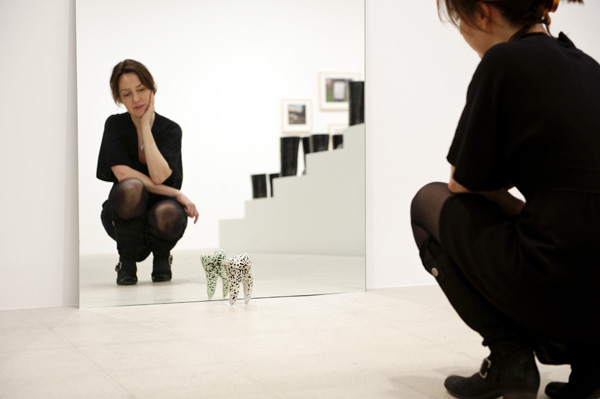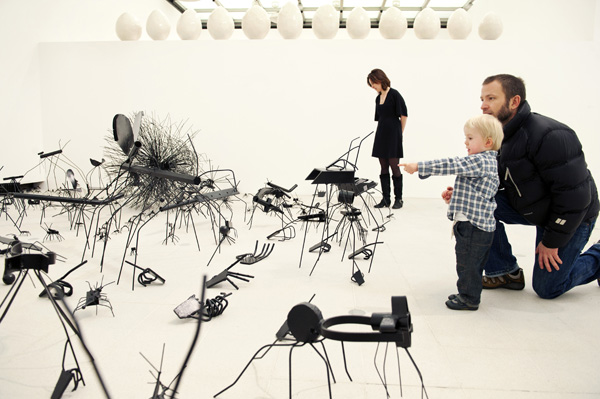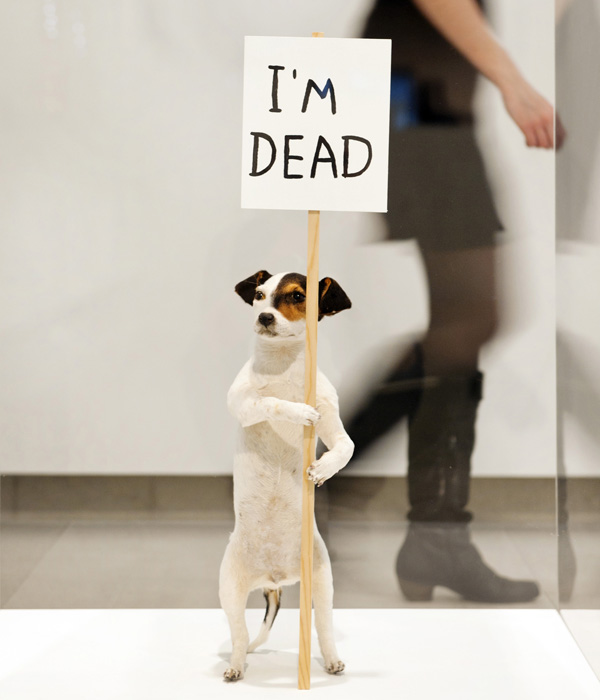Even though the Hayward Gallery offers a booklet to explain David Shrigley’s work with themes like ‘Headlessness’ and ‘Misshapen Things’, it’s hard to discern the thinking behind the 175 artworks that make up ‘Brain Activity‘ at London’s Southbank Centre. Large keys hang throughout the gallery in between the works beside which gallery assistants, stand like gate-keepers, ready to help. When asked his opinion on the animation New Friends, featuring a square trying to join a group of circles, Jules Gbokova says it is about going to a new school and immigration.

“If you can’t integrate you have to go,” he says, holding a programme thoroughly underlined in different colours, “The square is trying to dance with them, but he is square. He is screaming when they saw him into a circle, but they still did it. As human beings we behave exactly like that. It’s the same in a marriage. You should accept each other, instead of trying to turn the other into you.”
And the ostrich? Why hasn’t he got a head?
“It’s not why,” he suggests “It’s where. Hunters follow the ostrich but when he gets tired he doesn’t resolve the problem, he just hides from it. He should fight! But he doesn’t. He puts his head in the sand. This is like politicians who don’t resolve problems. They move them… He is an ostrich, hiding from his responsibility.”

Shrigley graduated from the Glasgow School of Art in 1991. He lives and works in Glasgow and his cartoons have been featured weekly in The Guardian from 2005 to 2009. Because of his use of taxidermy animals, he has been compared to Damien Hirst, who’s upcoming retrospective at the Tate Modern is the subject of much discussion. But while Hirst uses diamond studded skulls and suspended sharks in his work, Shrigley approached those themes of decay and human behaviour with ordinary objects, like eggs, teeth, squirrels and Rich Tea biscuits. His gold leaf engraved Gravestone (2008) is inscribed with the words ‘Bread, Milk, Cornflakes, Baked Beans, Tomatoes, Aspirin, Biscuits’ has the same message as Hirst’s For the Love of God but Shrigley’s preference for the everyday means you get less distracted by the object itself, while confronting your mortality.
Some works don’t need keys to be understood. Shrigley has written on them instead. A vat of paint has the word ‘ANTI-DEPRESSANT’ across it. A painting of an annoyed-looking woman says ‘PAINT YOUR WIFE’ across the top. Then there are two walls full of drawings, 80 of them in fact. That’s where the audience spends the most time; longer than looking at Shrigley’s more famous taxidermy dog I’m Dead. There is no effort on his part to beautify human beings or their behaviour through his drawings. There’s a couple pointing and saying, “such horrible little faces!” Amongst the drawings there is a great depiction of the concept of a career (see image), there is a worm rejoicing because he is wearing a sock and a girl trying to have a picnic with ants crawling up her. It is simple, effective comedy which he also achieves throughout the exhibition, such as when you discover that a barely-there hole in the wall is a viewfinder for a giant, pink worm sculpture hiding inside some partitions.

If you compare Shrigley to other comedic artists such as Banksy, his craft can sometimes come across as less ambitious. While he is busy crushing a ladder, enlarging a teacup or giving Barbie a pumpkin for a body, Banksy has stolen a telephone box, cut it in two and then put it back onto the street bent, with an axe in its ‘belly’ and red paint trickling onto the pavement. The comedy achieved by Banksy is more powerful because he had dared to impose his narrative on the viewer, rather than left it open to interpretation.
The Contents of the Gap Between the Refrigerator and the Cooker is a sculpture which in many way encapsulates the uniqueness of Shrigley’s work. Its cartoon-like appearance with bright Haribot-like creatures all squeezed one of top of each other, tongues out, elicit an urge to not just be looked at, but to be squeezed and played with. His art seems naive and edible but despite this, along with a giggling Shrigley introducing his work during an in-show film, Brain Activity is a fascinating display of very grown up things handled in very childlike ways .
David Shrigley’s Brain Activity is on at The Hayward Gallery, Southbank Centre, London Wednesday, February 1 to Tuesday, May 13.













